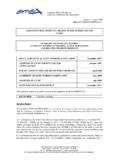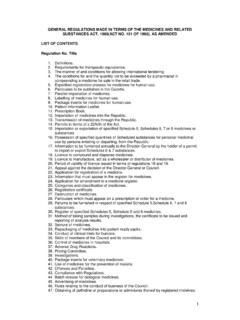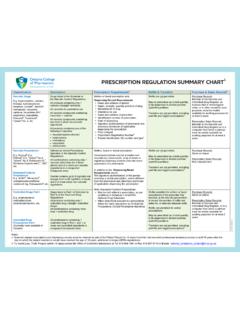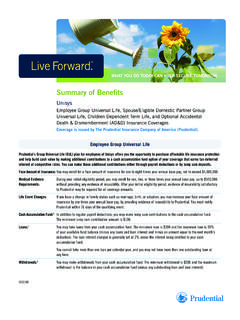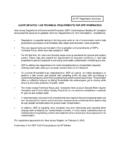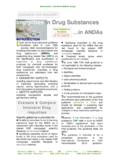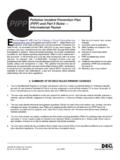Transcription of Printing Inks for Food Packaging - Hubergroup
1 Printing Inks for Food PackagingMHM Holding GmbH Feldkirchener Str. 15 85551 Kirchheim Functions of Packaging _____3 How Can Substances be Transferred? _____4 Responsibilities in the Food Packaging Production Process _____5 Legal Requirements _____6 Regulation (EC) No. 1935/2004 ("Framework Regulation") _____6 Regulation (EC) No. 2023/2006 ("GMP Regulation") _____6 Regulation (EU) No. 10/2011 ("Plastics Regulation") _____7 Resolutions of the Council of Europe _____7 National statutory regulations _____7 Summary of the statutory regulations _____8 GMP Good Manufacturing Practices _____9 GMP for printers/ Packaging manufacturers _____9 Demands on presses and the Printing process _____9 Factors that Influence Migration _____10 Printing Inks for Compliant Food Packaging _____12 MGA a special production standard.
2 _____13 Solvent-based inks for the gravure and flexo processes _____13 Sheet-fed offset inks _____14UV-curing inks and lacquers _____14 Water-based Printing inks for the flexo process _____15 Water-based coatings _____16 Methods of Testing Organoleptic Properties and Migration _____17 Robinson test _____17 Gas chromatography (GC) _____17 Measuring migration-capable substances _____18 Summary _____191st Edition November 2011, Rev. 1 Cover page: Helmut J. Salzer/pixelio3 Fig. 2: Folding carton packages, with and without an inner bagPrinting Inks for Food PackagingThe Functions of PackagingThe Packaging is the calling card of a product. It's the first visual and tactile impression the prospective purchaser gains in the shop.
3 In addition to the information describing the package contents, the packag-ing provides lots of other helpful references and tips about the goods inside. It tells the purchaser the price, size, condition and texture of the product, where and when it was made and when it should be used by. Food Packaging is an immensely important segment in the Packaging sector because it addresses both people's basic needs and quality-of-life issues. It provides the consumer with a range of information that can be of crucial importance to their health: the degree of freshness and ripeness, colour, shelf life, ingredients and nutritional values (such as the number of calories and fat content).
4 But details such as the country of origin, the weight and production methods can also be important factors in consum-ers purchasing decisions. Depending on the design, the customer is given suggestions on how to prepare and serve the food, and in what quantities. The Packaging also takes on practical functions, such as protecting its con-tents against damage and preventing them from going bad; it can also play an active role in ripening processes or extend a product s shelf life, to men-tion just a few of the functions above can only be fulfilled by Packaging if the pack-aging has Printing ink applied to it. Ink is the often unnoticed information medium that both simplifies and makes our lives safer in many respects.
5 More than 95% of all foodstuffs sold on the Western European market are packaged. Over the past years, the share of direct Packaging (with no inner bag) has increased. In this type of Packaging , the food comes into direct contact with the unprinted inner side of the Packaging material. The situation is different when the contents are packaged in an extra inner bag. Unfortunately, it is frequently and incorrectly assumed that this additional Packaging provides the contents inside with an adequate level of protection against substance transfers, but not every inner bag offers such of the products packaged by the food industry are organoleptically sensitive. Obviously, the Packaging must under no circumstances have a negative influence on the quality of what goes inside it.
6 Changes in smell or taste spoil people s enjoyment of the products and must therefore be prevented at all costs. After all, one of the main tasks of the Packaging is to prevent substances from transferring to the food. organoleptic: being perceived by human sen-ses. Organoleptics is the testing of foodstuffs in accordance with a specific rating system in relation to the quality-influencing properties, taste, odour, colour, appearance, shape reten-tion and consistency, without the use of aids but purely by means of the human senses. Fig. 1: Packages made of film, with and without an inner bag44 How Can Substances be Transferred?Transfer of substances from the Packaging to its contents can happen in three different ways: Through-migration Invisible set-off substance transfer via the gas phaseLike all of the other constituent components that go to make up Packaging , Printing inks and coatings consist of a multitude of different substances.
7 Substances of low molecular weight from the ink and coating films, as well as from the substrate, can pass through the substrate and to the food inside. This process is known as "through-migration".Due to the nature of the production process, the side of the Packaging that will face the contents of the package in the finished article comes into con-tact with the printed side while on the press (in the stack or on the reel). This means there is a possibility of colourless and therefore invisible ink con-stituents being transferred to the food contact side. This transfer is called "invisible set-off". These substances come into contact with the package contents, i. e. with the food, and can be transferred to it.
8 As is obvious from its name, invisible set-off is not visible. By the very nature of things, prints suffering from visible set-off are waste. Moreover, volatile substances in the enclosed air space inside the packag-ing can transfer to the food via the gas phase and have a negative effect on its smell or Europe folding cartons and to some extent paper wrappers, are fre-quently printed in the sheet-fed offset process. Standard Printing inks for the offset process use vegetable oils, mineral oils or low-molecular fatty acid esters as their solvent, whose migration to the food can be prevented only by the use of barrier are three different types of barrier that can be used for this purpose: Permanent barriers: glass and metals act as a reliable barrier to ink constituents.
9 In the case of aluminium foil, it has to be thicker than 7 m. Migration through perma-nent barriers is inherently impossible. Nevertheless, an eye has to be kept on the possibility of invisible set-off occurring in the finished Packaging . Plastics films and layers are functionally specific barriers i. e. plastics possess very different barrier properties in relation to different substances. For instance, while OPP films are a good barrier against water, they provide absolutely no barrier what-soever to many constituent components of Printing inks, such as mineral oils or some photoinitiators. In the case of plastics, the degree of migration that takes place is dependent on the migratable substances, the structure of the plastic layer and the temperature.
10 Non-functional barriers: paper and board pose no form of barrier at all to the low-molecular components of Printing inks. This means that the solvents described above are able to migrate through the substrate. Fig. 4: Invisible set-off on the reelFig. 5: substance transfer via the gas phasebarrier here is a layer within food contact materials or articles, preventing the mi-gration of substances from behind that barrier into the food and vice 3: Migration through the substrateFilmPrinting inkLaminating adhesiveLaminating film5 Responsibilities in the Food Packaging Production ProcessClear specifications of the Packaging and proper communication during all phases of production is mandatory and helps avoid complaints.
